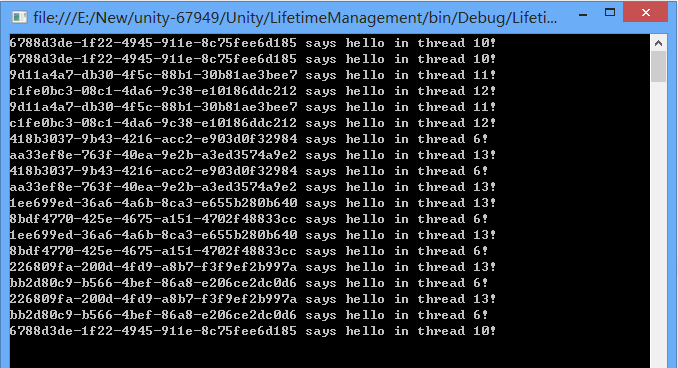自定义Unity基于PerCall的生存期模型
PerThreadLifetimeManager的问题
使用Unity内置的PerThreadLifetimeManager生存期模型时,其基于ThreadStatic的TLS(Thread Local Storage)设计,也就是说对于每个托管的ManagedThreadId,其会缓存已生成的对象实例。
由于CLR维护了托管线程池,使用过的线程并不会立即销毁,在需要的时候会继续复用。在类似ASP.NET PerCall或WCF PerCall条件下,当Call1在线程ManagedThreadId1中处理完毕后,Call2发生,而Call2很有可能也在线程ManagedThreadId1中处理。这种条件下Call2会自动复用处理Call1时生成并缓存的对象实例。
如果我们希望每次调用(PerCall)都生成专用的对象实例,则PerThreadLifetimeManager在此种场景下不适合。
解决办法有两种:
- 继续使用PerThreadLifetimeManager模型,不适用ThreadPool,而手动创建和销毁线程。
- 自定义对象生存期模型
PerCallContextLifeTimeManager
public class PerCallContextLifeTimeManager : LifetimeManager { private string _key = string.Format(CultureInfo.InvariantCulture, "PerCallContextLifeTimeManager_{0}", Guid.NewGuid()); public override object GetValue() { return CallContext.GetData(_key); } public override void SetValue(object newValue) { CallContext.SetData(_key, newValue); } public override void RemoveValue() { CallContext.FreeNamedDataSlot(_key); } }
使用举例
private static void TestPerCallContextLifeTimeManager() { IExample example; using (IUnityContainer container = new UnityContainer()) { container.RegisterType(typeof(IExample), typeof(Example), new PerCallContextLifeTimeManager()); container.Resolve<IExample>().SayHello(); container.Resolve<IExample>().SayHello(); Action<int> action = delegate(int sleep) { container.Resolve<IExample>().SayHello(); Thread.Sleep(sleep); container.Resolve<IExample>().SayHello(); }; Thread thread1 = new Thread((a) => action.Invoke((int)a)); Thread thread2 = new Thread((a) => action.Invoke((int)a)); thread1.Start(50); thread2.Start(55); thread1.Join(); thread2.Join(); ThreadPool.QueueUserWorkItem((a) => action.Invoke((int)a), 50); ThreadPool.QueueUserWorkItem((a) => action.Invoke((int)a), 55); Thread.Sleep(100); ThreadPool.QueueUserWorkItem((a) => action.Invoke((int)a), 50); ThreadPool.QueueUserWorkItem((a) => action.Invoke((int)a), 55); Thread.Sleep(100); ThreadPool.QueueUserWorkItem((a) => action.Invoke((int)a), 50); ThreadPool.QueueUserWorkItem((a) => action.Invoke((int)a), 55); Thread.Sleep(100); example = container.Resolve<IExample>(); } example.SayHello(); Console.ReadKey(); }





【推荐】编程新体验,更懂你的AI,立即体验豆包MarsCode编程助手
【推荐】凌霞软件回馈社区,博客园 & 1Panel & Halo 联合会员上线
【推荐】抖音旗下AI助手豆包,你的智能百科全书,全免费不限次数
【推荐】轻量又高性能的 SSH 工具 IShell:AI 加持,快人一步
· 深入理解 Mybatis 分库分表执行原理
· 如何打造一个高并发系统?
· .NET Core GC压缩(compact_phase)底层原理浅谈
· 现代计算机视觉入门之:什么是图片特征编码
· .NET 9 new features-C#13新的锁类型和语义
· Sdcb Chats 技术博客:数据库 ID 选型的曲折之路 - 从 Guid 到自增 ID,再到
· 语音处理 开源项目 EchoSharp
· 《HelloGitHub》第 106 期
· Spring AI + Ollama 实现 deepseek-r1 的API服务和调用
· 使用 Dify + LLM 构建精确任务处理应用